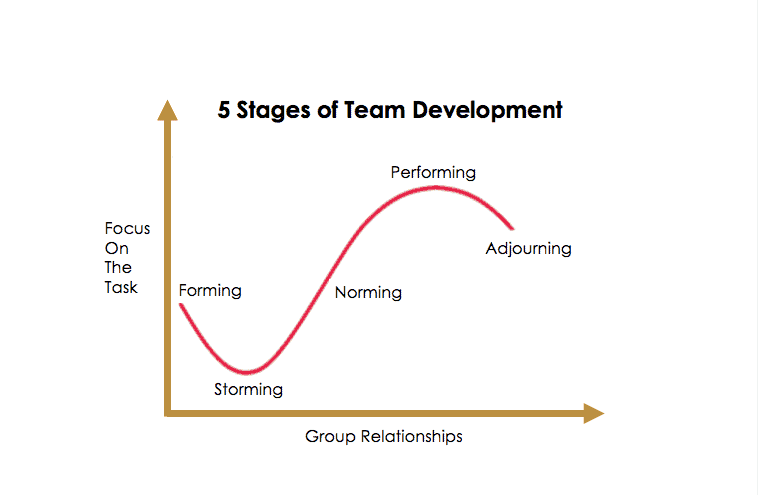As a team leader, you need to understand 5 stages of team development to stick to your mission. It will help you have a clear view of what needs to be done and know the effective leadership style for each stage, allowing you to build teams, resolve conflicts easily, achieve the best results, and continuously improve team capacity.
With the advent of new workplace models such as remote and hybrid models, it now seems unnecessary to require every member of the team to work in a fixed office. But for that reason, team leaders also need to learn more skills and be more strategic in managing and developing their teams.
To turn a group into a high-performing team, the team needs to constantly have clear direction, goals, and ambitions from the start, and the captain must find ways to ensure team members are aligned and on the same page.
Table of Contents
- 5 Stages of Team Development
- Stage 1: Forming
- Stage 2: Storming
- Stage 3: Norming
- Stage 4: Performing
- Stage 5: Adjourning
- Key Takeaways
- Frequently Asked Questions

Start in seconds.
Get any of the above examples as templates. Sign up for free and take what you want from the template library!
🚀 To the clouds ☁️
The Five Stages of Team Development is a framework created by Bruce Tuckman, an American Psychologist, in 1965. Accordingly, team development is divided into 5 stages: Forming, Storming, Norming, Performing and Adjourning.

This is the journey of working groups from being built to stable operation over time. Therefore, it is possible to identify each stage of team development, determine the status, and make accurate decisions to ensure the team achieves the best performance.
However, these stages are also not required to be followed sequentially, because the first two stages of Tuckman team development revolve around social and emotional competence. And phases three and four focus more on task orientation. So, do your research carefully before starting to apply for your team!
Stage 1: Forming - Stages of Team Development
This is the stage when the group is newly formed. Team members are unfamiliar and begin to get to know each other to collaborate for immediate work.
At this time, members may not yet clearly understand the goal of the group, as well as the specific tasks of each person on the team. It is also the easiest time for the team to make decisions based on consensus, and there are rarely sharp conflicts because everyone is still cautious with each other.
In general, team members will mostly feel excited about the new task, but they will be hesitant to approach others. They will spend time observing and polling people around to position themselves in the team.

Since this is a time when individual roles and responsibilities are unclear, team members will:
- Highly dependent on the leader for guidance and direction.
- Agree and accept team goals received from leadership.
- Test for themselves if they are a good fit for the leader and the team.
Therefore, the leader's task now is to:
- Be prepared to answer a lot of questions about the group's goals, objectives, and external relationships.
- Help members understand the purpose of the group and set specific goals.
- Unify general rules to ensure group activities.
- Observe and evaluate members and assign appropriate tasks.
- Motivate, share, communicate and help members catch up faster.
Stage 2: Storming - Stages of Team Development
This is the stage of facing conflicts within the group. It occurs when members begin to reveal themselves and can break the group's established rules. It is a difficult period for the team and can easily lead to bad outcomes.
Conflicts stem from differences in working styles, manners, opinions, cultures, etc. Or members may also be dissatisfied, easily compare their duties with others, or worry when not seeing the progress of the work.
As a result, it is difficult for the group to come to decisions based on consensus but instead argues and blame each other. And more dangerous is that the internal group begins to split and factions form, leading to a power struggle.

But even though this is also a period where members often can't focus on work towards a common goal, they do begin to get to know each other better. It is important that the group recognizes and confronts its condition.
What the leader needs to do is:
- Help the team get through this phase by making sure everyone listens to each other, understands each other's perspectives, and respects each other's differences.
- Encourage team members to bring a unique perspective to the project, and all will have ideas to share.
- Facilitate conversations during team meetings to keep the team on track.
- It may be necessary to make compromises to make progress.
Stage 3: Norming - Stages of Team Development
This stage comes when members begin to accept each other, accept differences, and they try to resolve conflicts, recognize the strengths of other members, and respect each other.
Members began to communicate with each other more smoothly, consulting with each other and asking for help when needed. They can also start to have constructive opinions or come to a final decision through surveys, polls, or brainstorming. Everyone begins to work for common goals and has a stronger commitment to work.
In addition, new rules could be formed to reduce conflicts and create a favourable space for members to work and collaborate.

The norming stage can be interwoven with the storming stage because when new problems arise, the members can fall into a state of conflict. However, work efficiency during this period will be enhanced because the team can now focus more on working towards a common goal.
Stage 3 is when the team agrees on common principles and standards regarding how the team is organized and the work process (instead of a one-way appointment with the team leader). So this is when the team has the following tasks:
- The roles and responsibilities of members must be clear and accepted.
- The team needs to trust each other and communicate more.
- The members started giving constructive criticism
- The team strives to achieve harmony within the team by avoiding conflicts
- Basic rules, as well as team boundaries, are established and maintained
- The members have a sense of belonging and have a common goal with the team
Stage 4: Performing - Stages of Team Development
This is the stage when the team achieves the highest work efficiency. The work goes on easily without any conflict. This is a stage associated with the so-called high-performing team.
At this stage, the rules are followed without any difficulty. Mutual support mechanisms in the group work well. The enthusiasm and commitment of the members to the common goal are unquestionable.
Not only do the old members feel very comfortable working in the group, but the newly joined members will also quickly integrate and work effectively. If a member leaves the group, the group's work efficiency will not be seriously affected.

In this phase 4, the whole group will have the following highlights:
- The team has a high awareness of strategy, and goals. And understand why the team needs to do what they're doing.
- The team's shared vision was formed without the intervention or involvement of the leader.
- The team has a high degree of autonomy, can focus on its own goals, and makes most of its decisions based on the criteria agreed upon with the leader.
- Team members take care of each other and share existing communication, work style, or workflow problems to solve.
- Team members can ask the leader for assistance in personal development.
Stage 5: Adjourning - Stages of Team Development
All fun will come to an end, even with work when project teams last only for a limited time. This happens in different situations, for example, when a project has ended, when most members leave the team to take up other positions, when the organization is restructured, etc.
For the dedicated members of the group, this is a period of pain, nostalgia, or regret, and it can be a feeling of loss and disappointment because:
- They love the stability of the group.
- They have developed close working relationships with colleagues.
- They see an uncertain future, especially for the members who haven't seen a better yet.
Therefore, this stage is also the time when the members should sit together, evaluate, and draw experiences and lessons for themselves and their teammates. That helps them develop better for themselves and when joining new teams later on.

Key Takeaways
The above are the 5 stages of team development (especially applicable to teams of 3 to 12 members), and Tuckman also offers no advice on the time frame specified for each phase. Therefore, you can apply it according to the status of your team. Only the important thing is that you need to know what your team needs and how it fits into the direction of management and development at each stage.
Don't forget that your team's success also depends on the tools you use. AhaSlides will help your team increase productivity, make presentations fun and interactive, meetings, and training no longer boring, and do a thousand other wonders.








